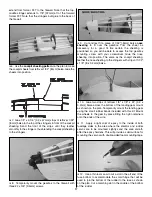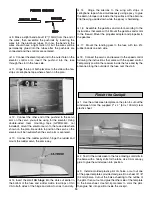
The electric motor and motor battery used in your Li’l Poke
are very powerful and the spinning propeller has a lot of
momentum; therefore, if you touch the propeller while it is
spinning it may inflict severe injury. Respect the motor and
propeller for the damage it is capable of and take whatever
precautions are necessary to avoid injury. Always
disconnect and remove the motor battery until you are
ready to fly again and always make sure the switches are
turned off before connecting the battery.
Read and abide by the following Academy of Model
Aeronautics Official Safety Code:
GENERAL
1. I will not fly my model aircraft in competition or in the
presence of spectators until it has been proven to be airworthy
by having been previously successfully flight tested.
2. I will not fly my model aircraft higher than approximately
400 feet within 3 miles of an airport without notifying the
airport operator. I will give right of way to and avoid flying in
the proximity of full scale aircraft. Where necessary an
observer shall be utilized to supervise flying to avoid having
models fly in the proximity of full scale aircraft.
3. Where established, I will abide by the safety rules for the
flying site I use and I will not willfully and deliberately fly my
models in a careless, reckless and/or dangerous manner.
7. I will not fly my model unless it is identified with my name
and address or AMA number, on or in the model.
RADIO CONTROL
1. I will have completed a successful radio equipment
ground check before the first flight of a new or repaired
model.
2. I will not fly my model aircraft in the presence of
spectators until I become a qualified flyer, unless assisted
by an experienced helper.
3. I will perform my initial turn after takeoff away from the pit,
spectator and parking areas and I will not thereafter perform
maneuvers, flights of any sort or landing approaches over a
pit, spectator or parking area.
4. I will operate my model using only radio control
frequencies currently allowed by the Federal
Communications Commission.
Though the Li’l Poke is a “Park Flyer” that may be flown in
small areas, the
best
place to fly
any
R/C model is at an
AMA chartered club field. Club fields are set up for R/C
flying making your outing safer and more enjoyable. We
recommend that you join the AMA and a local club so you
can have a safe place to fly and have insurance coverage in
case of a flying accident. The AMA address and telephone
number are in the front of this manual.
Remember, if you
insist on flying on your own, do not fly the Li’l Poke
within five miles of any R/C club field, or interference
from your transmitter could cause a crash.
If there is no club or R/C flying field in your area, find a
suitable site that is clear of trees, telephone poles, buildings,
towers, busy streets and other obstacles. Since you are not
flying at a sanctioned AMA site, beware of others like
yourself who could be flying nearby on your frequency.
IMPORTANT:
Although the Li’l Poke is a slow-flying model,
it does not have the self-righting characteristics of a primary
trainer. If you have not mastered basic flight with a trainer
model, we strongly urge you to seek the assistance of an
experienced R/C pilot to check the model for airworthiness
AND to teach you how to fly. Attempting to learn to fly on
your own is dangerous and may result in destruction of your
model or even injury to yourself and others. Therefore, find
an instructor and fly only under his or her guidance until you
have acquired the skills necessary for safe and fully
controlled operation.
We recommend flying the Li’l Poke when the wind is no
greater than five miles per hour. Less experienced flyers
should fly the Li’l Poke only in calm (less than one mile per
hour) conditions. Often, winds are calm in the early morning
and early evening. These are usually the most enjoyable
times to fly anyway!
Until you have the Li’l Poke properly trimmed for level flight,
we recommend having an assistant hand-launch the model
instead of taking off from the ground.
Turn on the transmitter and plug the battery into the speed
control.
IMPORTANT:
Confirm that the transmitter operates the
controls by moving the sticks to turn on the motor and move
the control surfaces. If you forget to do this you could
accidentally launch the model without having control!
Takeoff
FLYING
FIND A SAFE PLACE TO FLY
AMA SAFETY CODE (
excerpts
)
23




































